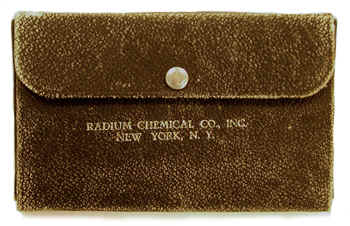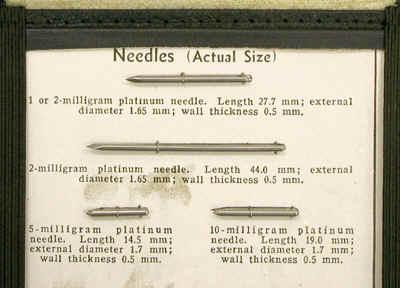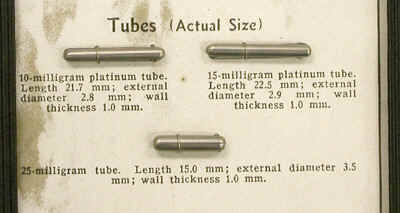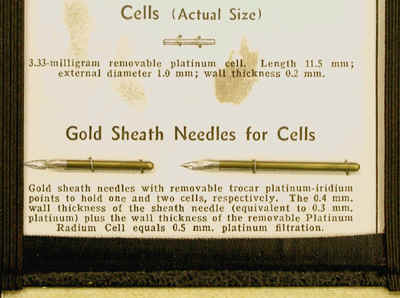Radium Chemical Co. Needles and Tubes (ca. 1940s to 1950s)

This velvet-lined black leatherette case contains example (dummy) radium needles and tubes of the type distributed by the Radium Chemical Company of New York City. It would have been used by a salesman to show a prospective buyer the various alternatives.
Needles were intended to be inserted directly into the diseased tissue, whereas tubes were used for intracavity therapy, or superficial therapy wherein they were placed on the surface of the body.

The text in the case is self-explanatory. Note however that a reference to 1, 2, 5, 10 etc milligrams refers to the amount of radium-226 that the needle or tube was designed to hold. For what its worth, one milligram of Ra-226 is essentially the same as one millicurie of Ra-226. As a rule, approximately one milligram of radium was used per cc of irradiated tissue. The examples in this case are made of platinum and gold but other materials were also used, e.g., steel, and monel metal.
Needles and tubes were either "American Type" or "European Type." With "American Type" needles and tubes, the radium was sealed directly inside. "European Type" needles and tubes, on the other hand, would hold smaller containers called cells in which the radium was sealed. If damaged, the American type devices were more likely to leak, but they could hold more radium than a European type device of the same outer dimensions.
Needles

These are "American Type" needles.
Although it is difficult to see, the top two needles in the photo to the right have Trocar points (three flat sides). The bottom two needles have conical points.
The eyelets for the thread in the top two needles are standard Rainure eyelets (the hole is at the bottom end of a groove). The bottom two needles use Bulldog eyelets (a simple hole drilled through the end of the tube).
Tubes
The tubes in the photo are "American Type."
Needles were somewhat more versatile than tubes, but as the text indicates, the tubes would hold more radium.
While it can't be seen in the photo, the top two tubes use standard Rainure eyelets while the bottom tube employs a bulldog eyelet.
Gold Sheath Needles

The two needles in the photo to the right are "European Type" needles which would contain one or more cells. Unfortunately, the cell in the display case is missing. If present, it would look like a solid metal wire or tube. It would not have a point or eyelet.
The trocar tips are identified as being "platinum-iridium." As a rule, this meant 90% platinum and 10% iridium.
They have bulldog eyelets.
Donated by a kind friend.
References
- Paterson. The Treatment of Malignant Disease by Radium and X-rays. Edward Arnold & Co. London. 1948.
- Union Miniere du Haut Katanga Radium Department. Radium. Brussels. No date. ca. 1928-1930.
- X-Ray and Radium Industries Limited catalog. No date. ca. 1950s.
